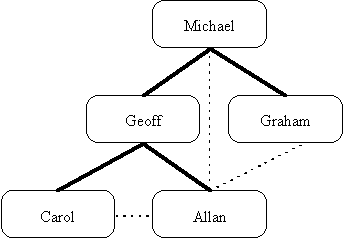
There are likely to be changes to the roles and responsibilities of people who provide input to and receive
output from the processes that are to be outsourced.
In an organization that is outsourcing its IT department, there
may be other people, in other departments who had responsibilities for checking outputs, so that the finance department may
had been responsible for checking payments to suppliers through the accounts payable system and payments to staff through
the payroll system. The outsourcer may also have a new responsibility for checking these amounts and for reporting them. To
avoid duplication of effort, there must be clear statements of who has the responsibility for such checking when the outsourcer
is appointed.
One way to avoid some of the difficulties that may arise is to have a set of proper maps of the
organization's command and communication structures.
Many people still think that this can be satisfied by using an
organization chart.

Figure 33.1: Organization chart
This organization chart shows that Allan reports to Geoff and communicates with Carol, Graham and
Michael.
As soon as we see an organization chart, we start to ask questions.
"Why does Allan bypass
Geoff to report to Michael?"
"What for?"
"Why should Allan report across to
Graham?"
"What for?"
"What information does Allan pass to the other four
people?"
"How much information does he pass to more than one person?"
The problem is that
organization charts only ever showed us the "Who" of an organization. They did not answer any of the
"What", "When", "How" and "Why" questions.
It is not unlikely, if
we took each of the tasks that Allan has to do, that we might be able to draw a separate, different organization chart for each
one.
Responsibility matrix
We can draw a responsibility matrix for each person and each task.
The codes
to be used for each person and task are:
| D | makes decisions alone |
| d | makes decisions jointly |
| P | monitors or controls progress |
| X | performs the task |
| C | must be consulted |
| I | must be informed |
| A | may be able to advise |
| T | provides tuition |
If we apply these codes to some sample tasks (called A, B and C), we may find the following.
| A | B | C | |
|---|---|---|---|
| Michael | |||
| Geoff | DP | DP | DP |
| Allan | X | X | X |
| Brian | X | X | X |
| Carol | X |
Table 33.2: Responsibilities
The true picture of roles and responsibilities is now emerging. Geoff had responsibility for decision making on
them and for controlling their progress.
If we remove these tasks to the outsourcer, there should be no impact on the
decision making and progress controlling responsibilities. They remain with Geoff.
The true magnitude of the mistake
created by giving Allan a supervisory role to replace the actual work that he performed to complete these tasks is now also
apparent. If Geoff had responsibility for progress before, he should continue to have it when these tasks are
outsourced.
In fact, what often happens is that a form of confusion settles into organizations who do not build a
responsibility matrix. The confusion is caused by people like Geoff not knowing if they still have their previous roles in decisions
and progress. Very often, they may assume that they no longer do have these roles, and that they have moved to the outsourcer
or to someone else in their organization.
The existence of a responsibility matrix that shows the 'before"
picture will help to develop the "after" picture. The organization will have to look at each of the activities and tasks
and determine where the responsibilities will lie in future.
We can now amend this matrix by moving the actual
execution of the tasks to the outsourcer.
| A | B | C | |
|---|---|---|---|
| Michael | |||
| Geoff | DP | DP | DP |
| Allan | |||
| Brian | |||
| Carol | |||
| Contractor | X | X | X |
Table 33.3: Responsibilities after outsourcing
Decisions
We now have some decisions to make.
"Should Geoff continue to make decisions on
each of the tasks?"
"Should he continue to control progress?"
If the decision is that Geoff
should remain in those two roles, then that is a good enough decision.
In addition, the procedure has re-confirmed
that Geoff does occupy those two roles, and that the outsourcer should report to him for them. The lines of communication will
be established by discussion and agreement, rather than by default because no-one understood the "before"
picture.
Other decisions may move one or other of the responsibilities to someone else. They may even be moved to
the outsourcer. What matters here is that there is a clear understanding of which roles and responsibilities belong to whom.
Mistakes
The most common mistakes that arise if this exercise is not performed are that
- the original person responsible for decisions and control believes that they no longer have those responsibilities
- another person can assume some of those responsibilities, as we saw with Allan earlier
- the outsourcer can assume that it has responsibilities and roles that have not been agreed with the client organization
- the client organization can assume that the outsourcer has roles and responsibilities that the outsourcer has not agreed to assume.
Copyright © 1996-2025